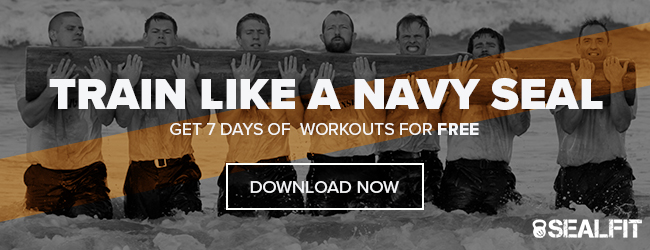The energy and restoration demands of the SEALFIT training program require an optimized, high-performance diet. Our recommendations include certain tweaks to what is popularly known as the Paleo diet. In this article, we’ll explore this crucial topic both in terms of the underlying science and thought as well as practical advice on how to make SEALFIT fueling both doable and affordable.
Understanding the Paleo Diet
If the Paleo diet (aka the Caveman diet or low-inflammation diet) sounds like a bookstore gimmick to you, I’d ask you to consider some of the historical facts supporting it before making any assumptions about what it is and whether it might work for you or not.
In a paper on “evolutionary health promotion,” published in 2001 in Preventative Medicine, researchers laid out the essential argument for how the changes wrought in our food supply through the agricultural revolution and subsequently the industrial age have been a root cause of the type 2 diabetes epidemic (and other chronic diseases) that is laying waste to the greater American population and costing us roughly $147 billion dollars annually.
From the research paper:
Since the appearance of behaviorally modern humans perhaps 50,000 years ago and particularly since the Neolithic Revolution of 10,000 years ago, cultural evolution has proceeded more rapidly than has genetic evolution, thereby producing ever-greater dissociation between the way we actually live and the lifestyle for which our genome was originally selected.
This discordance fosters the chronic degenerative diseases that cause most morbidity and mortality in contemporary affluent nations.
A logical model for prevention research (and, potentially, for health recommendations) is an amalgamation of the lifestyles prevailing among early, behaviorally modern humans, before agriculture accelerated genetic-cultural evolutionary divergence.
Wander the rows of a modern day supermarket and it starts to makes sense: most of the “foods” jammed onto the shelves—in supermarkets, there are an average of 43,884 products you can choose from—are designed so for unnatural objectives, like long shelf lives and being cheap to produce (and hence more profitable).
As my buddy Robb Wolf will tell you, a key target in industrial food-making is also “hyper-palatibility”—foods that are processed to trip pleasure circuits in your brain that will drive you into shoving more and more of the crap into your mouth. In a disturbing New York Times Magazine story on the modern science of food processing, the journalist handed a food scientist two bags of store-bought food to talk about.
From the article:
He zeroed right in on the Cheetos. “This,” Witherly said, “is one of the most marvelously constructed foods on the planet, in terms of pure pleasure.” He ticked off a dozen attributes of the Cheetos that make the brain say more. But the one he focused on most was the puff’s uncanny ability to melt in the mouth. “It’s called vanishing caloric density,” Witherly said. “If something melts down quickly, your brain thinks that there’s no calories in it . . . you can just keep eating it forever.”
 The Connection Between Food & Performance
The Connection Between Food & Performance
In my early days serving on the Teams, I had to come to grips with the ramifications I was enduring because I had adopted a bachelor diet that was more about convenience than it was nutrition. Pizza, milk, beer and other junk food. You may know the drill. I was fully committed to the SEAL mantra that The Only Easy Day Was Yesterday. But I wasn’t doing myself any favors with the diet I was eating. I woke up most days feeling like crap. I’d burn some of that feeling off with a 2-hour workout, but then I’d crash after lunch. I didn’t understand it at the time, but I was on the energy roller coaster that is caused by the massive insulin spikes that a diet high in processed food triggers.
It was on a deployment to the Philippines that I started to figure things out: Shifting to a diet of fresh chicken, fish and vegetables, the protein all range-fed or hand-caught. I immediately felt better. I looked around and noticed that the local citizenry looked amazingly healthy compared to what you might see in the States.
It was this dual experience that set me forward onto a new path of thinking about food and food’s relationship to performance and health.
Tips for Creating an Optimal Performance Diet
Follow these simple guidelines to get on the right path:
Eliminate sugar. Junk food, soda, products made with with high-fructose corn syrup.
Remove grain-based products from your diet at least 80% of the time. Many don’t think of cereal, bread and pasta as processed foods, but that’s exactly what they are. Supplant these foods with fresh vegetables and some seasonal fruits. Nuts and seeds are good too.
Eliminate cow’s milk, highly-processed cheeses and crappy yogurt. You may not be lactose-intolerant, so settling into a diet that has some dairy (ideally organic, full-fat grass-fed milk, cheese or yogurt) will fit fine into your plan, but the best way to understand how you’re physically reacting to a food is to remove it for a period of 30 days and then test it out to see how it affects you.
Eliminate most starches and legumes (beans, white potatoes, corn). Again, change these out for fresh vegetables and fruits. Sweet potatoes are okay. Eating rice the way you might a condiment is OK too.
Get rid of processed vegetable oils. Cheap vegetable oil is a primary ingredient used in the processed foods industry. As we’ll explore in more detail in this series, this is one of the culprits involved what can be termed “a high-inflammation” diet. Coconut oil is one of the best alternatives. Other good fats to install into your fueling plan are avocados, almonds and macadamia nuts.
Train hard and eat smart.
Leave a Reply cancel reply
You must be logged in to post a comment.




No Comments